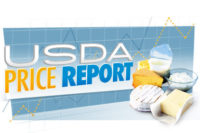In dairy processing news for the week of July 23 to 27, organic dairy advertising volume set a number of records; ice cream and cream cheese manufacturing account for the strongest demand on national cream supplies; and cheese production was reported slower as reduced volumes of milk were available for manufacturing, according to the USDA's Dairy Market News.
Following are highlights from this week's edition:
ORGANIC DAIRY: Organic dairy advertising volume set a number of records, even as record setting drought conditions weighed heavily over the agricultural sector. Due significantly to historically high retail organic half gallon milk ad volume in the Southwest and South Central regions, this period’s organic retail ad numbers are higher than any period since this data series began during fall 2009. This is true for organic milk, organic half gallons, and total organic dairy ads.
Organic dairy advertising volume increased by 183% from two weeks ago, organic half gallons increased by 249%, organic milk ads overall increased by 170%, and organic yogurt ads by 217%. The national weighted average advertised price of organic milk half gallons, $3.64, is 29 cents lower than two weeks ago. The price range is $4.99 to $2.39, unchanged at the top but 60 cents lower at the bottom. This price spread is the greatest for organic half gallons by 50 cents since this data series began during fall 2009.
FLUID MILK: Farm milk production is following the seasonal downward trend across the country. Contacts indicate fewer loads of milk traveled long distances to find processing room compared to last week, although milk loads are sometimes shipping between related plants to maximize efficiencies.
Shipments out of Florida declined for the third consecutive week, to 28 loads, compared to 39 loads last week and 120 loads 2 weeks ago. Class I demand to bottlers is mostly steady while store ads running for 1 gallon containers increased 13% compared to 2 weeks ago.
Ice cream and cream cheese manufacturing account for the strongest demand on national cream supplies, followed by active interest to support sour cream and dip production. Many cream loads are transferring under contract agreements. Some butter churn operators indicate they are fulfilling cream contracts but are not selling into the spot cream market at this time.
Current butter demand is active with sales increasing as the market value of butterfat increases. Because of the active sales and existing contracts for butter, some butter manufacturers are concentrating on rebuilding butter inventories and withdrawing cream loads from the spot market. Dairy farmers continue the evaluation process on herd size, feed on hand, input needs, and other variables.
CHEESE HIGHLIGHTS: Cheese production was reported slower this week as reduced volumes of milk were available for manufacturing. The recent hot weather across much of the country has contributed to lower component levels in milk along with reduced volumes. Demand for cheese remains good with some increased interest being expressed to build inventories before anticipated price increases. Export demand has slowed but continued assistance from the CWT program is helping to move international sales. The NASS Cold Storage report showed stocks of natural cheese (total) at the end of June nearly unchanged from a year ago.
Read the full report, which includes regional breakouts and pricing trends.

